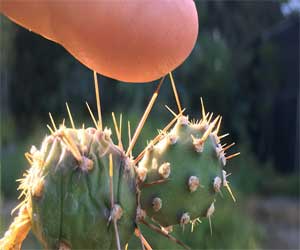- Home
- Editorial
- News
- Practice Guidelines
- Anesthesiology Guidelines
- Cancer Guidelines
- Cardiac Sciences Guidelines
- Critical Care Guidelines
- Dentistry Guidelines
- Dermatology Guidelines
- Diabetes and Endo Guidelines
- Diagnostics Guidelines
- ENT Guidelines
- Featured Practice Guidelines
- Gastroenterology Guidelines
- Geriatrics Guidelines
- Medicine Guidelines
- Nephrology Guidelines
- Neurosciences Guidelines
- Obs and Gynae Guidelines
- Ophthalmology Guidelines
- Orthopaedics Guidelines
- Paediatrics Guidelines
- Psychiatry Guidelines
- Pulmonology Guidelines
- Radiology Guidelines
- Surgery Guidelines
- Urology Guidelines
First successful removal of cactus spines in a patient: A Case Report

USA: Doctors at Akron City Hospital report the first successful removal of cactus spines (stuck on a patient) by using several pairs of adhesive OR (operating room) hair removal mitts and conscious sedation through intramuscular ketamine. The patient had an efficient, painless resolution of her injury without the need for additional spine removal. The case is published in the Case Reports in Emergency Medicine.
"Injuries from cactus spines can present challenges to Emergency Medicine providers. When the patient has mental limitations that prevent cooperation with removal, these challenges grow. Traditional removal techniques have several drawbacks including prolonged time for complete removal and incomplete removal," write the authors.
The case is of a 22-year-old girl inflicted with cactus spine injury to a large surface area of her chest, abdomen, and extremities. She was was morbidly obese with limited ability to ambulate, and had a history of low-functioning autism and congenital motor dysfunction.
Andrew M. Ford, Department of Emergency Medicine, Summa Health – Akron City Hospital, Akron, OH, USA, and colleagues present a case where a patient fell into a cactus glochidia and received dozens of thorn injuries.
This method is not without its shortcomings. For one, the mitts would not be sufficient to retrieve a deeply embedded glochidium or spine. For these, ultrasound-guided removal using tweezers is a well-documented approach. OR mitt removal would not be ideal for addressing injuries caused by cacti with larger spines; these injuries also tend to be amenable to tweezer removal, note the authors.
"With the rising popularity of ornamental cacti in areas where they are not indigenous, it is important to be aware of the injuries that they may cause and how to treat them. Our case demonstrates a novel removal method that proved particularly useful for treating a widespread glochidia injury in a combative patient. This method could prove useful for treating similar injuries in other patients, be they combative or compliant. It may prove to be more efficient than other methods such as tweezers and adhesive tape," they concluded.
To read the complete case report follow the link: https://doi.org/10.1155/2019/6062531

Disclaimer: This site is primarily intended for healthcare professionals. Any content/information on this website does not replace the advice of medical and/or health professionals and should not be construed as medical/diagnostic advice/endorsement or prescription. Use of this site is subject to our terms of use, privacy policy, advertisement policy. © 2020 Minerva Medical Treatment Pvt Ltd